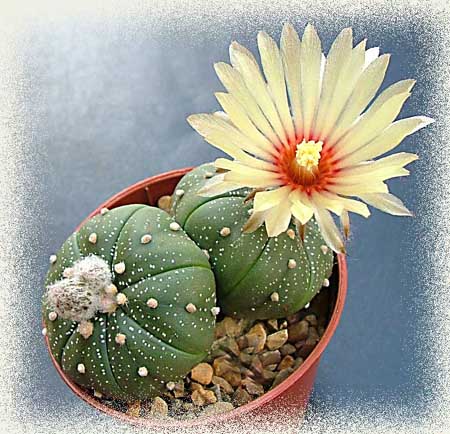
Growth Habits: The plant is almost always solitary, with a globular body, flattened and slightly depressed at the apex, with 6 to 8 ribs. It can attain approx. 6in. (15cm.) in diameter, but this is a good specimen. It has no spines, but prominent felted areoles. Plants vary tremendously in the amount of flecking they have covering the epidermis which is usually darkish green. Some plants have very little or no flecking where others are virtually covered as in the ‘Super Kabuto’ varieties. Many collectors have dozens of different forms all differing from each other in some way.
Scientific name: Astrophytum asterias
Common names: Sand Dollar cactus, Sea Urchin Cactus, Star Cactus
Synonym: Echinocactus asterias
Etymology: Astrophytum: The generic name "Astrophytum" derives from the Greek words astron, meaning a star and phyton, meaning plant. (The Genus name implies: "star plant"). Asterias: Derives from the Greek name aster which means a star and the Greek suffix ias meaning “likened to, comparable, similar.”
Origin: This plant is native to the Chihuahuan Desert along the border between Texas and Mexico.
Light: Requires full sun to help the plant to flower well
Compost: Well drained compost with added grit. The plant also prefers an alkaline soil.
Water: Water with care as the plant has a tendency to rot at the roots
Flower: The flower is predominantly yellow as with other Astrophytum, but in the case of asterias the flower has a deep red throat, yellow anthers and stamens. The petals have a silky sheen to them.
Fruit: The fruit is a greyish red, with black helmet shaped seeds that are quite large and germinate fairly easily, particularly when fresh.
Min. temp: 45°f (7°c). It will stand lower temperatures for short periods if the soil is bone dry.
Cultivation: The plant needs a coarse compost that for preference should be slightly alkaline and can be kept in full sunshine. I have always moved them into a clay pot after two or three years growth, as they seem much happier (I don’t know why), but the clay or terracotta pots do dry out that much quicker. This plant tends to bloom at irregular intervals through the summer months. If they weather becomes really hot it tends rest and stop growing. Do not water the plant unless you are sure it is growing.
Habitat: There are many threats to this plant in its native habitat, not least the collection of plants for the cactus trade and conversion of its habitat for urban land use and agriculture. Many exotic grasses have also been introduced for cattle fodder and the plant is in competition with these.
Comments: Cacti like fashion tend to come and go in cycles, but whatever cacti I have had in my collection I have also found room for two or three of these at different stages of growth. The plant has a tendency to reach its optimum growth size and then collapse, although to get to this stage will take a number of years So it is a wise move to have at least one following on. This I am happy to say is not down to my cultivation, but something that seem to be a common trait among all growers of this wonderful plant. Some of the kabuto forms sell for large sums of money and the Japanese seem to have cornered the market in producing these plants.
This cactus was discovered more than 120 years ago by a Baron Karwinski. He sent some specimens to St. Petersburg. These were never seen again, but he also sent a specimen to J. Zuccarini, then a professor at Munich University, who in 1845 described it as Echinocactus asterias. This specimen also died and the species was thought to be extinct until in 1923, A. V. Fric recognised it on a visit to the botanical gardens in Mexico City.
My Astrophytum asterias pictured above shows the unusual growth of two bodies, both growing at the same rate, joined at the base and sharing one root system. Perhaps a Siamese twin of the plant kingdom?










